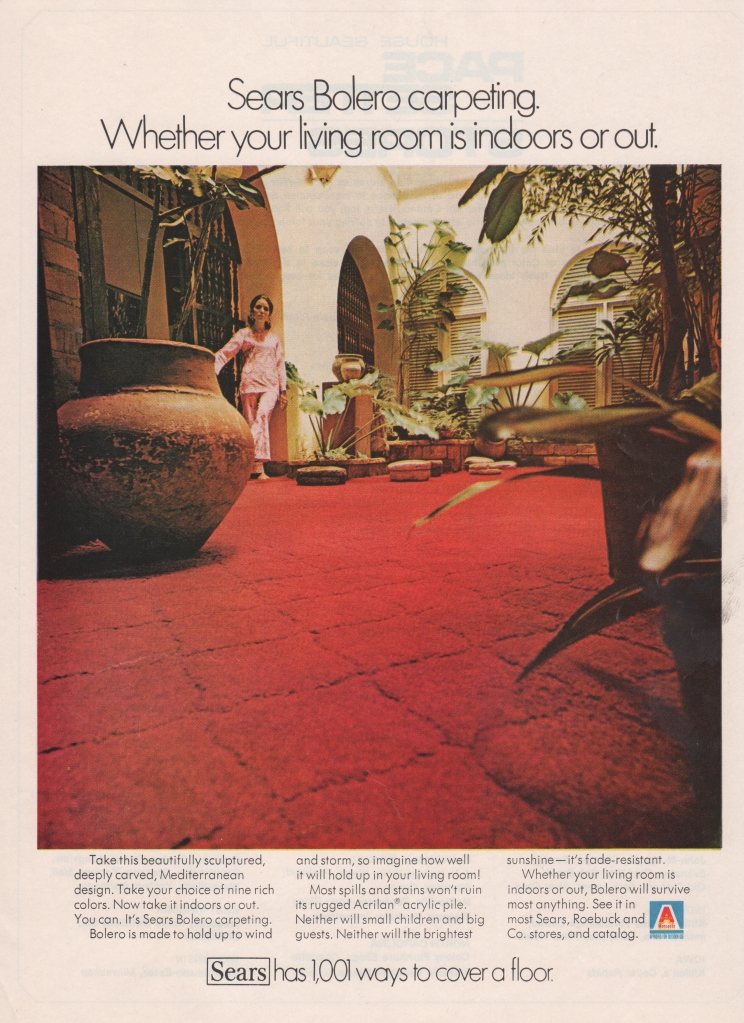
In the seventies, carpets were a way to signal a certain level of middle and upper-middle-class affluence. As such, they could be found almost everywhere.
Today, stained wood stands as a similar socioeconomic indicator, at least in coastal American culture. There is the angle by which this is purely contrarian signaling — the upper-class picks a style (e.g. carpeting); the lower tiers of society take note (in part through magazines which capitalize on this impulse, from which I’ve scanned the images embedded in this post); and the upper-class again switches sides to distinguish itself. We can also see that the very act of keeping up with such trends — constantly adapting and remodeling, ripping everything out anew — is both a culturally evolved mechanism of economic consumption and a way to additionally advertise one’s affluence. Like a peacock with feathers, “I have enough money (and have succeeded so well at the American Dream) that I can afford to constantly tear out my entire interior and build it back from scratch.”
Yvain, who himself writes occasionally as if a seventies interior marketer:
An undesirable man might “come up to a woman without a hint of romance, promise her nothing, and demand sex. A more sophisticated man might buy roses for a woman, write her love poetry, hover on her every wish, et cetera; this signifies that he is not a total loser. But the most desirable men may deliberately avoid doing nice things for women in an attempt to signal they are so high status that they don’t need to.”
Sometimes, this signaling proves so egregious that you end up with carpeted driveways. All that luxury floor coverage is actually meant to be driven on, put into contact with some of the dirtiest objects available (car wheels). It’s a practice not wholly dissimilar from running over iPhone 7s as a party trick; here however, housewives gain an additional benefit of furthering their entropic warfare against grime, keeping their minds off the carbon monoxide vents at the back of their husbands’ Cadillacs.


What’s interesting about the carpet-wood relationship is that there’s a certain efficiency or economy to it. Wooden floors accumulate scratches, nicks, and dents over time. Carpets are a way of preserving what’s underneath, so that when the wood is at last unveiled, it’s been perfectly protected from damage.
Carpets aren’t the only commodity favored in the seventies and now seen as tacky. This was a decade when packaged pies and Hostess confectioneries were perceived as luxury items. There is the common anecdote about white bread in the Medieval Ages being incredibly expensive, while whole grain loaves were eaten exclusively by peasants. Today, of course, that relationship is inverted. But it’s also true that the reversal happened not over hundreds of years but as recently as twenty to thirty years ago. All this creates a Pynchonesque fog of confusion in our perception of the present-day. Things which seem as if they must be objectively better — nutritionally, environmentally, aesthetically — might be better viewed in the long-term as more trend than truth. Even if one condescends on carpets today (especially of the toilet-cover variety), there is an undeniable fitness, a unity, present in the seventies interior design examples here. At the very least, we haven’t improved in our ability to build aesthetic cohesion. We’ve merely switched out the parts which interlock or cohere.



We might argue (cf. Perry) that carpets are more prone to literal (e.g. shag) and aesthetic mess. But they’re also replaceable, and can be fairly easily removed; despite their penchant for containing crumbs, we can also reframe this quality as one of concealing crumbs. Carpets are an adaptation towards cleanliness.
Seventies interior design is a partial byproduct of mid-century liberal naïveté towards progress’s potential, far more space-age and artificial than 21st century preferences. (Contrast the embedded images with the “naturalness” of glass mason jars, exposed brick, or natural wood.) Yet there is also in the seventies a move towards earth tones, a move towards natural lighting and highly visible potted plants, all of which evidences the seventies as more a last gasp, a final remnant, of the midcentury’s aesthetic and ideological positioning than its pinnacle. The design choices shown here only seem artificial in contrast with contemporary design; held up to the interiors of the 1950s, they suddenly appear as beacons of garden-utopic leaning. The seventies are a transitional decade, though perhaps no more than any other.
I’ve scanned in a dozen or so carpet advertisements from early seventies interior design magazines in an attempt to slowly build up an archive. Below are merely a few of the most interesting selections for perusal.







Leave a comment